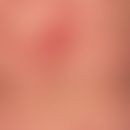Synonym(s)
HistoryThis section has been translated automatically.
Alfred Wiskott 1937 , Robert Aldrich 1954
DefinitionThis section has been translated automatically.
Rare, X-linked recessive combination of thrombocytopenia (bleeding tendency), eczema and T-cellular immunodeficiency (susceptibility to infection). See also Immunodeficiencies, T-cellular, primary.
You might also be interested in
Occurrence/EpidemiologyThis section has been translated automatically.
EtiopathogenesisThis section has been translated automatically.
Mutation of the WAS gene mapped to gene locus Xp11.23-p11.22 associated with consecutive WAS protein (WASp) disruption.
ManifestationThis section has been translated automatically.
ClinicThis section has been translated automatically.
Petechiae, melenae and diarrhea in the neonatal period. At the age of a few months eczematous skin changes and recurrent bacterial infections (abscesses, pneumonia, otitis media) and also infections with herpes viruses (herpes simplex, varicella zoster virus). Skin changes corresponding to atopic eczema, mainly localized on the head and extremities. Late-type skin reactions and chemotaxis of neutrophil granulocytes are reduced.
Malignant diseases, especially lymphoreticular tumors, occur more frequently in later life.
LaboratoryThis section has been translated automatically.
TherapyThis section has been translated automatically.
Collaboration with pediatricians and internists. Determine bleeding time. Causal therapy not possible, splenectomy. Chemotherapeutic agents only for symptomatic treatment. Prenatal and carrier diagnostics are required.
Therapy of choice: bone marrow transplantation from HLA-identical donor. Haploidentical bone marrow transplantation is also possible (with worse results).
Experimental: A potentially curative treatment is gene therapy of hematopoietic stem/progenitor cells (HSPC) mediated by lentiviral vectors. It represents an alternative to allogeneic HSPC transplantation (Ferrua F et al. 2019).
Progression/forecastThis section has been translated automatically.
LiteratureThis section has been translated automatically.
- Aldrich RA, Steinberg AG, Campbell DC (1954) Pedigree demonstrating a sex-linked recessive condition characterized by draining ears, eczematoid dermatitis and bloody diarrhea. Pediatrics 13: 133-139
- Dupuis-Girod S et al (2003) Autoimmunity in Wiskott-Aldrich syndrome: risk factors, clinical features, and outcome in a single-center cohort of 55 patients. Pediatrics 111: e622-627
Ferrua F et al. (2019) Lentiviral haemopoietic stem/progenitor cell gene therapy for treatment of Wiskott-Aldrich syndrome: interim results of a non-randomised, open-label, phase 1/2 clinical trial. Lancet Haematol 6:e239-e253.
- Greer WL, Higgins E et al (1989) Altered expression of leukocyte sialoglycoprotein in Wiskott-Aldrich syndrome is associated with a specific defect in O-glycolysation. Biochem Cell Biol 67: 503
- Huntley CC, Dees SC (1957) Eczema associated with thrombocytopenic purpura and purulent otitis media. Pediatrics 19: 351
- Lum LG, Tubergen DG, Corash L, Blaese RM (1980) Splenectomy in the management of the thrombocytopenia of the Wiskott-Aldrich syndrome. N Engl J Med 302: 892
- Nonoyama S et al (2001) Wiskott-Aldrich syndrome. Curr Allergy Asthma Rep 1: 430-437.
- Ochs HD, Lum LG, Johnson FL et al (1982) Bone marrow transplantation in the Wiskott-Aldrich syndrome. Transplantation 34: 284
- Ormerod AD (1985) The Wiskott-Aldrich syndrome. Int J Dermatol 24: 77-81.
- Sebire NJ et al (2001) Isolated EBV lymphoproliferative disease in a child with Wiskott-Aldrich syndrome manifesting as cutaneous lymphomatoid granulomatosis and responsive to anti-CD20 immunotherapy. J Clin Pathol 56: 555-557
- Snapper SB et al (2003) A family of WASPs. N Engl J Med 348: 350-351.
- Wiskott A (1937) Familial congenital Werlhof's disease? Mschr Pediatrics 68: 212-216
Incoming links (20)
Aldrich syndrome; Atopic dermatitis in infancy; Eczema-thrombo-cytopenia-immunodeficiency syndrome; Eosinophilia and skin; Hereditary thrombocytopenia; Ige; Immunodeficiency 2; Immunodeficient t-cell primary; Neutropenia; PID; ... Show allOutgoing links (4)
Atopic dermatitis (overview); Eczema (overview); Immunodeficient t-cell primary; WAS Gene;Disclaimer
Please ask your physician for a reliable diagnosis. This website is only meant as a reference.




